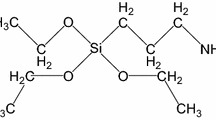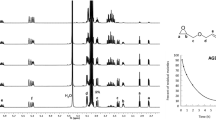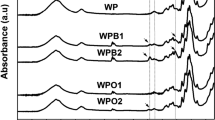Abstract
The surface modification of various cellulosic materials was studied in heterogeneous conditions using different grafting agents bearing anhydride or isocyanate reactive groups. Some of these reagents were oligomeric, others polymeric and most were chosen so as to provide a non-polar character to the surface of the fibres in view of their possible use as reinforcing agents in composites based on polymeric matrices. The success of these chemical modifications was assessed by Fourier-transform Infrared Spectroscopy, scanning electron microscopy, X-ray photoelectron spectroscopy and elemental analysis. The accessibility of the superficial OH groups varied as a function of the coupling agent in terms of both molecular size and chemical nature and ranged between 1 and 3% of the total hydroxy groups borne by the initial cellulose sample.
Similar content being viewed by others
Author information
Authors and Affiliations
Rights and permissions
About this article
Cite this article
TREJO-O'REILLY, JA., CAVAILLE, JY. & GANDINI, A. The surface chemical modification of cellulosic fibres in view of their use in composite materials. Cellulose 4, 305–320 (1997). https://doi.org/10.1023/A:1018452310122
Published:
Issue Date:
DOI: https://doi.org/10.1023/A:1018452310122




